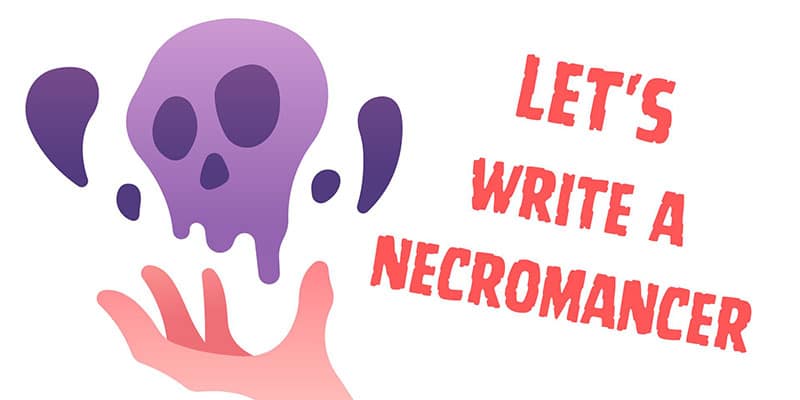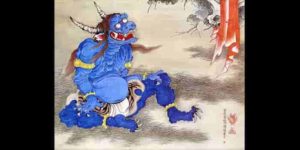Writing a necromancer character can vary depending on the culture, aesthetic, or character journey you are trying to develope. Naturally, they make terrifying villains with the ability to summon undead hordes. However, the archetype has a vast history of heroes and villains intertwined in its lineage.
- The Necromancer Archetype
- Necromancer Villains
- Liches
- Necromancer Heroes
- Interactions With The Underworld
The Necromancy Archetype
No doubt, Necromancer characters are intense. They play with the forces of life and death, crossing a line for many, so no matter what they’re intentions, they are gonna be dark in nature.
In a lot of ways, magic serves as a symbol for hidden knowledge, or knowledge itself. A necromancer character justifies their dangerous and dark form of mystic art, whether their intentions are good or evil.
The concept of a necromancer is as old as magic itself. Shamans communed with ancestral spirits around a fire in the early days of humankind, entering hypnotic states to speak with the dead and other spirits.
From these mystical places, the spellcaster could gather knowledge hidden from humanity—secrets from the other side or the realm of the gods. Who knows how far back this tradition goes. Strangely enough, this practice survived throughout human history—just check out how popular Ouija boards still are.
Necromancer villains
Villains are the first thought most people have when it comes to necromancers. Naturally, any character who can summon ghosts or zombies to do their bidding can easily fall into the evil category. But what truly makes a necromancer character a villain is their lust for power.
And this power comes from seemingly unknowable knowledge—something kept from mankind for a reason.
Matters of revenge and general psychopathy are perfect motivators for the necromancer villain and their search for knowledge at all costs. You can even start their journey into darkness with noble intent—kind of like the way Anakin Skywalker fell to the dark side after losing his mother and foreseeing Padme’s death. Any way you shape it, they are willing to pay the steep price for their goals. And at some point, this steep price is taken from their soul.
Liches
What happens after the necromancer pays the entirety of that steep price? You get the infamous lich. Liches are super necromancers. They’re like a necromancer on steroids—they have been to the other side themselves and bring back horrible knowledge. You can see where that might amplify their necromancy quite a bit.
If you play any sort of RPG, you are aware of the lich archetype and what they usually resemble. Some Skeletor looking master of evil. However, there are some cool variants to the concept of an undead necromancer you could consider.
- Egyptian Aesthetic: Take influence from the best mummy movie to ever grace the planet—1997’s The Mummy with Brendan Frasier. This version of the mummy monster is elevated to a whole different level. Instead of a lumbering zombie wrapped in linen, they introduced us to an otherworldly being with incredible magic. He summons undead mummy minions, as well as Egyptian themed spells like controlling sandstorms and cursing the earth with the plagues of Egypt from the Bible. Death was a huge part of ancient Egyptian culture—and Anubis would be a cool entity to interact with.
- Vampire Aesthetic: Dracula is known to have learned magic from the Devil himself. And, being undead, this type of lore can lead to a unique version of a vampiric lich. Within vampire lore, biting a victim can create a new vampire or place a person under a hypnotic thrall state. Transform the hypnosis to a thrall zombie, and you have a vampiric necromancer who can create various undead minions.
- Winter Aesthetic: This one is straight from George R. R. Martin—but the ice necromancer that represents winter is a fantastic twist on the archetype. Winter has historically been a dark season where people became sick. The world outside hibernates or dies.
Odd Ball Examples
Let’s wrap up this sample list of villains with a couple of odd ball necromancers from literature.
- Sauron: So, Sauron is something way more powerful and evil than your ordinary necromancer. He was a dark god that got demoted to necromancer—an interesting concept on the archetype that could take a whole variety of forms. His first few adventures in Middle Earth were in various evil forms, one of which being a werewolf amongst a pack of werewolves. But after losing a fight to the legendary giant dog named Huan (the goodest boy to ever grace Middle Earth)—he was downgraded to a necromancer for a while, a lurking darkness in the background of Tolkien’s works that would lead up to the conflict in Lord of the Rings. In other words, take a being of immense power and humble them to walk the earth in a weaker state, and you can get some interesting story plots.
- Dr Frankenstein: Blasphemy! I would include a scientist in the world of magic? Yes, Dr Frankenstein is essentially after the same thing necromancers are after. The science is pseudo at best—lightening, in fact, does not bring a sewed-up collection of human body parts to life–but it makes for an interesting angle on the necromancer character.
Necromancer Heroes
Naturally, this archetype makes for fantastic Antiheroes or tragic heroes.
Related Posts:
Top 9 Scary Japanese Monsters in Mythology
| Guide to Writing a Paladin Character
|
So, what sort of backstories drive a decent character to study the art of necromancy? At the top of my list is heartache. A mage losing a loved one, a young wizard who was orphaned as a child, a new vampire with gifts they never chose but want to understand.
Heartache is one of those things people relate to the most. If you are trying to create a somewhat likable character with a dark aesthetic, you need a good reason for the darkness. Heartache is darkness. It’s the feeling we get when we lose a loved one, when we are rejected, or when we are lonely.
When the epic hero, Odysseus, was homesick, he summoned spirits from the underworld to gain an idea of what his voyage home would look like. However, he did need quite a bit of help from the powerful sorceress Cerci, so I wouldn’t quite call him a “necromancer”. That said, he is a good example of a hero tapping into this taboo power in a relatable way.
Example Heroes
- The Reluctant Medium: This character interacts with ghosts on a regular basis, but not by their own choice. Therefore, they delve into necromantic magic to learn more about this curse that has befallen them. This taps into the spirit aspect of necromancers as opposed to a gruesome zombie, and often they are empathetic to lost spirits who are seeking to move on.
- The Rebel: An order of wizards or spell crafters hold an unfair paradigm of power. This character is more of an antihero who turns to dark arts to push against this paradigm. This setup is a fantastic opportunity for a positive character arch—even if it starts out bleak. Sometimes even seemingly good magic can have a toxic effect if not balanced.
- The Dark Noble: This one is similar to my Sauron example, but with a positive character arc. An ex-demon revolts against their father, a demon lord, and is cast to the mortal realm as an enemy. Now, the being who was once a demon must reckon with the consequences of evil—the inability of loyalty or cooperation– and walk a new path. For this character, the undead summons could be loyal followers manifesting in the mortal world.
- The Regular in a Dark World: Maybe the setting itself is dark—something like a spooky Tim Burton world full of vampires, ghosts and goblins. Your necromancer would just be a wizard-like character in a gothic, Halloween-like setting.
Interactions with the Underworld
At the end of the day, there are going to be a near infinite number of ways your necromancer character can interact with the dead. This is because there are so many variations on the myths of death with expansive underworlds.
Naturally, writing a necromancer character is an opportunity to world build in interesting ways. Therefore, you want to be sure to use the elements you have and make spooky lands covered in darkness, fire or fog. Maybe the underworld is a dream landscape with surreal laws of physics.
Think about what other characters would make the setting interesting. Characters like Anubis or the Grim Reaper could be presented with various personalities attached. Anubis can be seen as a hero, a guardian who shows spirits the way beyond. The Grim Reaper could be a menacing villain in your story. On the other hand, he’s been used as a funny character to great effect.



